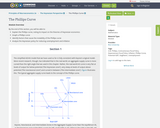
This video is 2 minutes long and will define stagflation for students. It will enforce the standard EPF. 5 (b)
- Subject:
- Economics
- Social Science
- Material Type:
- Lecture
- Provider:
- Marginal Revolution University
- Date Added:
- 10/31/2018

This video is 2 minutes long and will define stagflation for students. It will enforce the standard EPF. 5 (b)

Principles of Macroeconomics 2e covers the scope and sequence of most introductory economics courses. The text includes many current examples, which are handled in a politically equitable way. The outcome is a balanced approach to the theory and application of economics concepts. The second edition has been thoroughly revised to increase clarity, update data and current event impacts, and incorporate the feedback from many reviewers and adopters.Changes made in Principles of Macroeconomics 2e are described in the preface and the transition guide to help instructors transition to the second edition.


In this chapter, you will learn about:
Macroeconomic Perspectives on Demand and Supply
Building a Model of Aggregate Demand and Aggregate Supply
Shifts in Aggregate Supply
Shifts in Aggregate Demand
How the AD/AS Model Incorporates Growth, Unemployment, and Inflation
Keynes’ Law and Say’s Law in the AD/AS Model

By the end of this section, you will be able to:
Explain how productivity growth changes the aggregate supply curve
Explain how changes in input prices change the aggregate supply curve


By the end of this section, you will be able to:
Explain the Phillips curve, noting its impact on the theories of Keynesian economics
Graph a Phillips curve
Identify factors that cause the instability of the Phillips curve
Analyze the Keynesian policy for reducing unemployment and inflation

U.S. History is designed to meet the scope and sequence requirements of most introductory courses. The text provides a balanced approach to U.S. history, considering the people, events, and ideas that have shaped the United States from both the top down (politics, economics, diplomacy) and bottom up (eyewitness accounts, lived experience). U.S. History covers key forces that form the American experience, with particular attention to issues of race, class, and gender.Senior Contributing AuthorsP. Scott Corbett, Ventura CollegeVolker Janssen, California State University, FullertonJohn M. Lund, Keene State CollegeTodd Pfannestiel, Clarion UniversityPaul Vickery, Oral Roberts UniversitySylvie Waskiewicz


By the end of this section, you will be able to:Explain the factors responsible for Richard Nixon’s election in 1968Describe the splintering of the Democratic Party in 1968Discuss Richard Nixon’s economic policiesDiscuss the major successes of Richard Nixon’s foreign policy